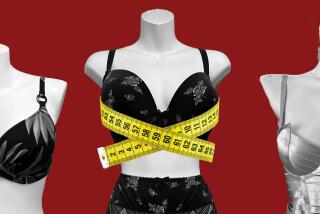Southern California Brides : The Dress May Fit, but Where’s It From? : Retail: Many bridal shops are ripping the labels off gowns, hindering shoppers from finding bargains.
- Share via
WASHINGTON — Here comes the bride, and she wants to know where her dress came from.
Brides-to-be often find that retailers have cut manufacturers’ tags out of wedding gowns so consumers won’t be able to comparison-shop or, worse yet, buy them cheaper off the Internet. The Federal Trade Commission is cracking down on these “tag rippers,” which is what some consumers call bridal shops that engage in the practice.
They complain that the help at such shops feigns ignorance about the disappearance of the tags. In other cases, retailers offer the names of designers only after customers plunk down hefty deposits.
What this means is that a bride-to-be searching for a particular dress--such as an Alfred Angelo or an Illissa--that she may have heard about at a trunk show or seen in a magazine has a tougher time bargain-hunting. Without the label, it’s also more difficult to tell if the dress is a knockoff.
With the wedding season in full bloom, prospective brides have more than a passing interest in the cost of a wedding dress. The dress accounts for about 8% of the wedding budget and sets a bride back an average of about $800. Add a headpiece, veil and alterations, and the total is often more than $1,000. Designer dresses, particularly those made of silk and other natural fabrics, can cost thousands of dollars.
For many women, a bridal gown is the most formal dress they will ever wear, and a purchase laden with emotion. So it comes as a surprise that many of the 5,000 or so bridal shops nationwide won’t tell them whose dress they are buying, where it was made or what fabrics it contains.
“It’s sold as a fairy-tale experience . . . but then you get smacked in the face with shops that play these games,” said Alan Fields, who, with his wife, Denise, co-wrote the “Bridal Gown Guide.” In one chapter, “The Ugly Truth About Bridal Retail Shops,” the authors advise that brides huff out of the eight out of 10 shops that they estimate cut tags to hide the identities of the gowns.
“We believe it’s a deceptive trade practice to remove the brand name of a product, to advertise you carry the brand and then refuse to identify it when a consumer comes in,” Fields said.
Shearing off the label violates the FTC’s Textile Act and its Care Labeling Rule. But, Fields points out, until recently the agency didn’t pay much attention: Retailers who were ripping with impunity were quite sure they wouldn’t be caught. FTC officials “have been asleep for the last 20 years,” he said.
That hasn’t been the case recently. The FTC said that in the last six to eight months it has sent more than 3,000 warnings to retailers and manufacturers, advising them that removing--or never including--a label bearing the manufacturer’s name, country of origin, care instructions or fabric content is illegal unless another label is substituted.
“Now that there can be no uncertainty about what is required, we expect full compliance,” said Elaine Kolish, the FTC’s associate director of enforcement.
Under the law, it’s legal to remove the original tag from the dress, according to the FTC. But if the tags go, retailers must provide the name of someone else in the distribution chain or a code that the buyer can trace through the FTC to find the manufacturer or retailer. The care instructions must never be removed, and the other information must be sewn in or placed on a hang tag. Records must be kept for three years by manufacturers and retailers.
“It’s perfectly legal for a store to put its own name in the dress if they choose,” said Gary Wright, chief executive of the National Bridal Service in Richmond, Va., which represents 1,200 bridal-related businesses. He doesn’t believe tag ripping is rampant, but shops that do it, he said, are protecting themselves from “free riding” by no-inventory dress dealers that advise customers to go and try on the dress and get the goods on it.
Other representatives of the bridal industry said the advent of the Internet and discount bridal operations that use catalogs and toll-free numbers have turned their traditional retail facilities into showrooms. In other words, brides come in and “test drive” the dress they will eventually buy somewhere else.
“It’s really ravaged our industry,” said Susan White, editor of the Bridal Information Resource, a newsletter for retailers. She said many bridal retailers own just one shop with annual sales of less than $200,000, making every sale count.
Bridal salons also face a shrinking market for formal weddings and stiff competition from quickly expanding chains selling off-the-rack bridal dresses.
Sandy Leibowitz, owner of Martin’s Bridal & Formal Shop in Baltimore, said she is amazed at the number of stores that cut out tags, thinking they will stop brides from shopping elsewhere.
“If they do go somewhere else, shame. Shame on us if we can’t sell them,” said Leibowitz, who leaves the tags intact on her dresses. She also runs a separate mail-order business.
She said today’s brides, many of whom are older than their predecessors, sometimes entering on their second or third marriages, are also savvier and more attuned to the marketplace.
As for the grooms, this problem just doesn’t exist.
“When a guy goes shopping for a tux, the labels are all there,” Fields said. Not that he’d be looking: The bride usually picks the groom’s attire, and on average it costs a mere $95 for a rental--including alterations, of course.
More to Read
Inside the business of entertainment
The Wide Shot brings you news, analysis and insights on everything from streaming wars to production — and what it all means for the future.
You may occasionally receive promotional content from the Los Angeles Times.









